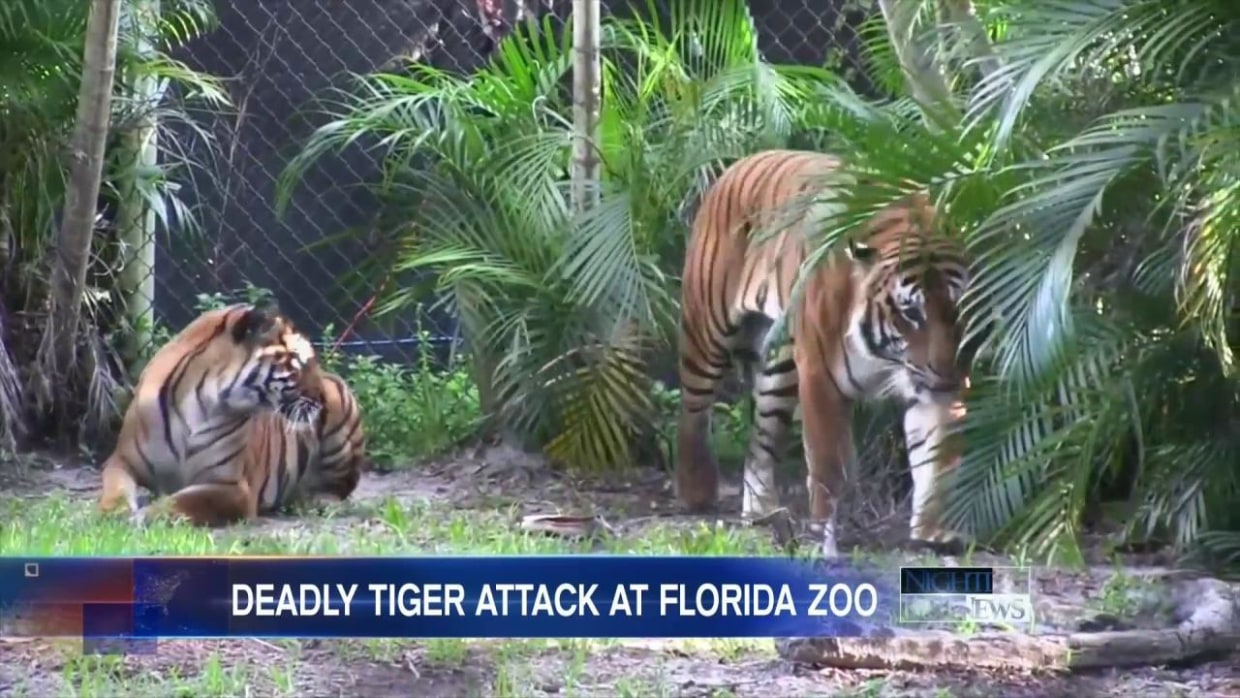Report: Zookeeper Screamed for Help Before Tiger Attack
By terry spencer, associated press
FORT LAUDERDALE, Fla. — Sep 23, 2016, 6:47 PM ET
A zookeeper screamed for help into her radio before she was fatally attacked by a Malayan tiger, but the 350-pound animal crushed her neck before her co-workers could reach her, an autopsy report released Friday showed.
The Palm Beach County medical examiner determined that Stacey Konwiser, 38, died of a fractured spine, a lacerated jugular and other neck injuries suffered when she was attacked on April 15 by the tiger named Hati.
The male tiger, then 12 years old, had been at the zoo for two years on loan from the zoo in Fort Worth, Texas.
Konwiser had entered the tigers' night house, an area where they eat and sleep that is not visible to the public, to prepare for a presentation.
The report by medical examiner investigator Aleita J. Kinman says the tiger's cage was supposed to be locked, but it was open, and Konwiser's view of the animal may have been blocked by a large box inside the enclosure.
Hearing her screams, Konwiser's co-workers rushed to the tiger exhibit and found the tiger standing over her body.
Zoo officials have defended their decision not to shoot the rare tiger, saying they feared a bullet could strike Konwiser or further enrage Hati if it didn't kill him instantly.
Instead, they tried unsuccessfully to lure him into a cage before shooting him with a tranquilizer dart. Paramedics were able to reach her 17 minutes after the attack. She was taken to the hospital and pronounced dead.
No cameras were operating in the area of the attack. Officials have said they are only used to monitor breeding efforts, so were turned off.
There are only about 300 adult Malayan tigers in the wild and they are considered endangered.
Zoo officials didn't immediately return a call Friday seeking comment. Investigative reports on the attack by the Florida Fish and Wildlife Conservation Commission and the Occupational Safety and Health Administration are pending.
Konwiser had worked at the Palm Beach Zoo for three years after working at the Palm Springs, California, zoo.
Konwiser had given notice that she had accepted a job with the Food and Drug Administration, but the zoo had offered to match her salary and give her new responsibilities in an effort to keep her. She had not given a decision. Her husband, Jeremy, is a Palm Beach Zoo employee.
========
Palm Beach, Florida, Zookeeper Mauled by Tiger Radioed for Help: Autopsy Report
by Elisha Fieldstadt
The Florida zookeeper mauled to death by a tiger earlier this year screamed for help into her radio before the deadly encounter — but she was crushed before anyone could respond, according to an autopsy report released Friday.
Tiger expert Stacey Konwiser, 38, died of a fractured spine, a lacerated jugular and other neck injuries when she was attacked April 15 by a 350-pound Malayan tiger named Hati at the Palm Beach Zoo, the Palm Beach County Medical Examiner said, according to The Associated Press.
The autopsy listed Konwiser's cause of death as an accident.

FROM April 15: Tiger Mauls Zookeeper to Death at Florida Zoo 1:46
Konwiser had entered the 12-year-old tiger's night house — an area not visible to the public and where cameras were turned off — when she was attacked.
The report said co-workers ran to the enclosure after hearing Konwiser's screams but when they got there, the tiger was standing over her bloodied body.
Records from West Palm Beach Police and Palm Beach County Fire Rescue show that medics weren't able to render aid to Konwiser until 17 minutes after the initial call to police. The medics said they had to wait for a tranquilizer to take effect on the animal before they could go safely into the enclosure.
Konwiser died at a nearby hospital.

Stacey Konwiser. Joe Forzano / Palm Beach Post via ZUMA
The Palm Beach Zoo was heavily criticized for choosing to tranquilize the tiger instead of shooting the animal.
Palm Beach Zoo spokeswoman Naki Carter thanked the Palm Beach County Medical Examiner on Friday for "diligent and professional work," but said the report "contains what we believe to be inaccuracies."
A statement from the zoo said that all employees who responded to the scene had been interviewed and none said they heard her radio for help or saw the tiger standing over her body.
The zoo said Konwiser broke protocol by entering the enclosure, which a U.S. Department of Agriculture report released in May also concluded.
Konwiser had worked at the Palm Beach Zoo for three years after a stint at a zoo in Palm Springs, California.
Before Konwiser's death, the zoo said, she had given notice that she had accepted a job with the Food and Drug Administration, but they had tried to keep her on. Her husband, Jeremy Konwiser, also worked at the Palm Beach Zoo.
==============
Palm Beach Zoo Under Fire for Tranquilizing, Not Shooting, Tiger in Fatal Mauling
by Elizabeth Chuck
When a Malayan tiger — an endangered cat that can grow to nearly 300 pounds — attacked Palm Beach Zoo keeper Stacey Konwiser last Friday, zoo officials had two options: They could use deadly force on the tiger, or they could tranquilize him.
Attempting to fatally shoot an animal that's mauling a human comes with the risk of accidentally shooting the person you're trying to save. But tranquilizers can take as long as 10 minutes to kick in, letting potentially life-saving minutes tick by while the animal is still alert enough to pose a threat.
Palm Beach Zoo chose to tranquilize the tiger, and Konwiser, 38, was airlifted in critical condition to a hospital, where she later died of her injuries.

Stacey Konwiser. Joe Forzano / Palm Beach Post via ZUMA
Since then, the zoo has come under fire for its choice to "tranq," which West Palm Beach police say prevented paramedics from immediately entering the zoo enclosure where Konwiser was mauled. Neither police nor the zoo have said how long emergency personnel had to wait, citing the ongoing investigation.
The zoo stands by its decision, Palm Beach Zoo spokeswoman Naki Carter told NBC News on Thursday.

Zoo Assisting in Investigation Into the Death of Keeper Killed by Tiger 2:40
"We are equipped to tranquilize and we are equipped to shoot to kill," Carter said. "There are a lot of things to consider."
The kind of ammunition that would have taken down the animal "comes with a series of checks and balances," she added. "All those things have to be factored in. And based on what we know at this time, we are equipped to do both, and we stand by the decision to tranq."
Fatal attacks on humans by big cats in captivity have happened before: Since 1990, there have been 24 such deaths in the U.S., according to the Animal Legal Defense Fund.
All accredited zoos such as Palm Beach's have protocols in place for when an animal threatens zoo staff or the public.
"I think it would be helpful if you view this to how a police officer would react if he or she is confronted with a dangerous individual. There is a decision tree, or a progressive use of force, that has to be considered with every incident," Ed Hansen, CEO of the American Association of Zoo Keepers, told NBC News.
Zoos have trained shooters who are educated on weapon caliber, use of force, and circumstances under which to discharge weapons.
"The first item is, is the animal contained?" Hansen said. In the Palm Beach Zoo case, it was: Konwiser was in an enclosure where the tigers typically eat and sleep, and the tiger never posed danger to the public. "The second item is, can you separate the dangerous animal from the victim?"
Officials can create distance from an animal using non-lethal means, such as spraying a fire extinguisher at it. If that's not possible — not enough information has been released about Konwiser's situation to know — "this is where it gets very, very tricky," Hansen said.
"You have to use a high-caliber weapon, a rifle or a shotgun" to humanely kill the tiger, he said. "If you were looking at a small space, concrete construction holding area, you may not want to discharge a high-caliber weapon in that environment because it may ricochet or cause further complications. You could injure the shooter or additionally injure the victim." "There's an old saying that you can take an animal out of the wild, but you can never take the wild out of the tiger."
At Zoo Miami, where an animal keeper was killed by a tiger in 1994, if a cat or other large carnivore poses an imminent threat to people, "unfortunately that is a death sentence for that animal," communications director Ron Magill told NBC News.
"Our policy would be yes, if a tiger is on top of a human being here, we're not going to anesthetize it. We're going to shoot it to facilitate rescuing that human as quickly as possible."
"Seconds count in trying to save someone's life," he added.
David Hitzig, the executive director of the Busch Wildlife Sanctuary in Jupiter, Florida, echoed that.
"Human life is always going to take precedence," he told NBC News. "You always want the opportunity to be able to tranquilize the animal ... But when you run into a situation where obviously you have human life in jeopardy, whether it's in a confined area or whether you have an animal escape and you're not in control of the situation, then you have to look at lethal means."


